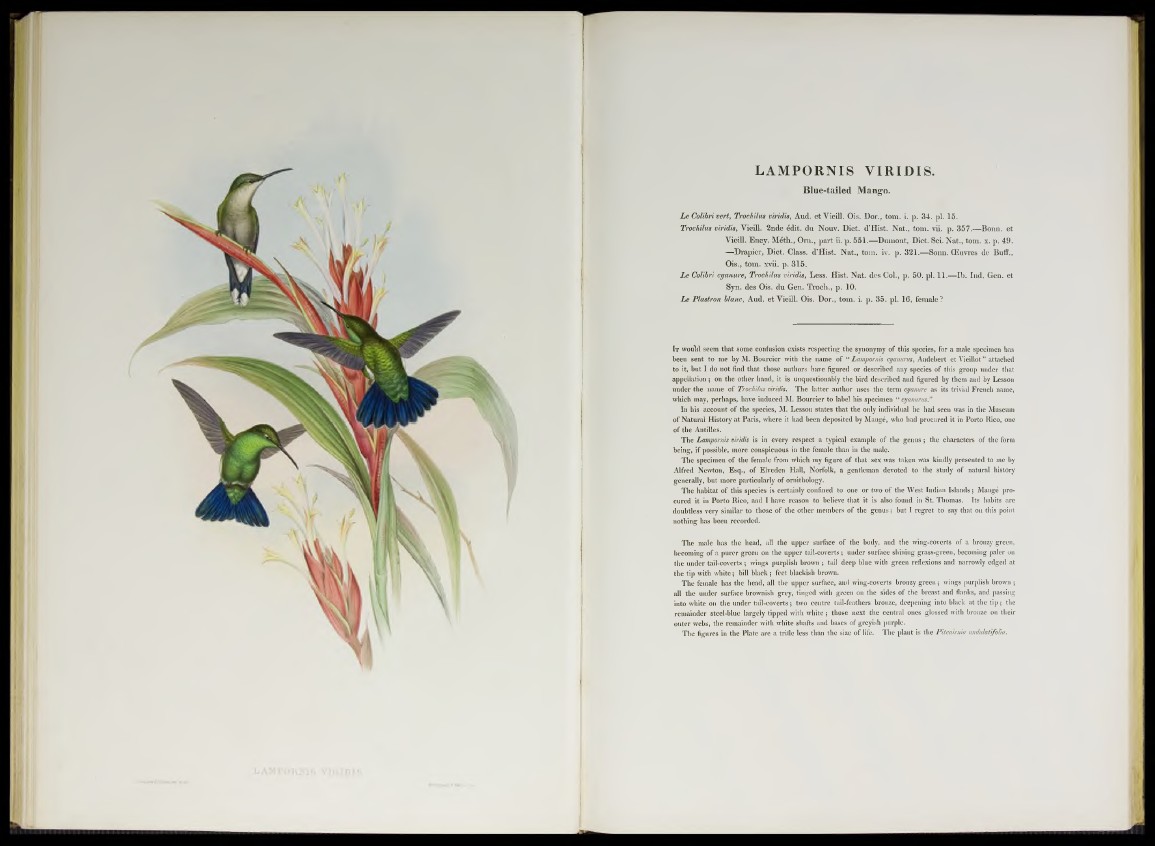
LAMPORNIS VIRIDIS.
Blue-tailed Mango.
Le Colibri vert, Trochilus viridis, Aud. et Vieill. Ois. Dor., tom. i. p. 34. pl. 15.
Trochilus viridis, Vieill. 2nde édit. du Nouv. Dict. d’Hist. Nat., tom. vii. p. 357.—Bonn. et
Vieill. Ency. M éth., Om., part ii. p. 551.—Dumont, Dict. Sei. N at., tom. x. p. 49.
—Drapier, Dict. Class. d’Hist. Nat., tom. iv. p. 321.—Sonn. (Euvres de Buff.,
Ois., tom. xvii. p. 315.
Le Colibri cyanure, Trochilus viridis, Less. Hist. Nat. des Col., p. 50. pl. 11.—Ib. Ind. Gen. et
Syn. des Ois. du Gen. Troch., p. 10.
Le Plastron blanc, Aud. et Vieill. Ois. Dor., tom. i. p. 35. pl. 16, female?
It would seem that some confusion exists respecting the synonymy of this species, for a male specimen has
been sent to me by M. Bourcier with the name of “ Lampornis cyanurus, Audebert et Vieillot ” attached
to it, bnt I do not find that those authors have figured or described any species of this group under that
appellation; on the other hand, it is unquestionably the bird described and figured by them and by Lesson
under the name of Trochilus viridis. The latter author uses the term cyanure as its trivial French name,
which may, perhaps, have induced M. Bourcier to label his specimen “ cyanurus.”
In his account of the species, M. Lesson States that the only individual he had seen was in the Museum
of Natural History at Paris, where it had been deposited by Maugé, who had procured it in Porto Rico, one
of the Antilles.
The Lampornis viridis is in every respect a typical example of the genus; the characters of the form
being, if possible, more conspicuous in the female than in the male.
The specimen of the female from which my figure of that sex was taken was kindly presented to me by
Alfred Newton, Esq., of Elveden Hall, Norfolk, a gentleman devoted to the study of natural history
generally, but more particularly of ornithology.
The habitat of this species is certainly confined to one or two of the West Indian Islands; Maugé procured
it in Porto Rico, and I have reason to believe that it is also found in St. Thomas. Its habits are
doubtless very similar to those of the other members of the genus; but I regret to say that on this point
nothing has been recorded.
The male has the head, all the upper surface of the body, and the wing-coverts of a bronzy green,
becoming of a purer green on the upper tail-coverts; under surface shining grass-green, becoming paler on
the under tail-coverts ; wings purplish brown ; tail deep blue with green reflexions and narrowly edged at
the tip with white; bill black; feet blackish brown.
The female has the head, all the upper surface, and wing-coverts bronzy green; wings purplish brown ;
all the under surface brownish grey, tinged with green on the sides of the breast and flanks, and passing
into white on the under tail-coverts; two centre tail-feathers bronze, deepening into black at the tip; the
remainder steel-blue largely tipped with white; those next the central ones glossed with bronze on their
outer webs, the remainder with white shafts and bases of greyish purple.
The figures in the Plate are a trifle less than the size of life. The plant is the Pitcairnia undulatifolia.